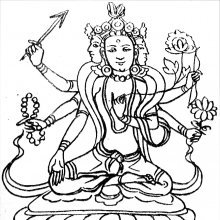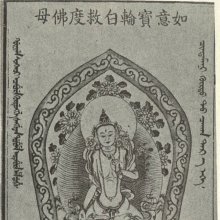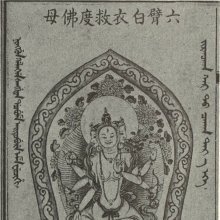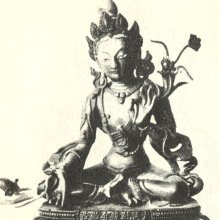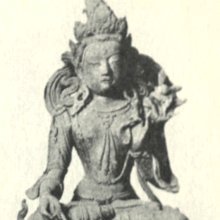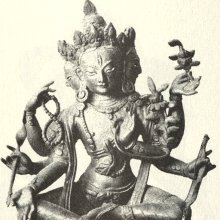Sitatara, Sitatārā: 3 definitions
Introduction:
Sitatara means something in Buddhism, Pali, Hinduism, Sanskrit. If you want to know the exact meaning, history, etymology or English translation of this term then check out the descriptions on this page. Add your comment or reference to a book if you want to contribute to this summary article.
Images (photo gallery)
In Buddhism
Tibetan Buddhism (Vajrayana or tantric Buddhism)
Source: archive.org: The Indian Buddhist Iconography1) Sitatārā (सिततारा) refers to one of the various emanations of Amoghasiddhi, as mentioned in the 5th-century Sādhanamālā (a collection of sādhana texts that contain detailed instructions for rituals).—Her Colour is white; her Mudrā is the utpala; she has four arms.—Sitatārā, as the name implies, is a Tārā of white variety with one face and four arms. She is accompanied by two goddesses Mārīcī and Mahāmāyūrī. It may be remembered that Khadiravaṇī also is accompanied by Mārīcī and Ekajaṭā; but the difierence is that Khadiravaṇī is two-armed whereas Sitatārā is four-armed.
The Dhyāna (meditation instructions) of Sitatārā described in the Sādhanamālā as follows:—
“The worshipper should visualise himself as the goddess Sita (Sitatārā) of white complexion, with three eyes and four arms. She bears the images of the five Dhyāni Buddhas on her crown, is decked in many ornaments, exhibits the utpala-mudrā with the first pair of hands, displays the varada-mudrā along with the cintāmaṇi jewel in the second right, and carries the utpala bud in the second left, and fulfils the prayers of all beings.
To her right is Mārīcī who is yellow in complexion, sits on the moon, is clad in blue garments, is two-armed, and carries the bough with red Aśoka flowers in the left hand and the cāmara in the right. She wears a red jacket and ornaments.
To her left is Mahāmāyūrī of green colour, like the Priyaṅgu fruit, who is two-armed and carries the peacock’s feathers in the left hand and the cāmara in the right. Thus meditating...”
2) Sitatārā (सिततारा) can also refer to Ṣaḍbhujasitatārā: another one of the various emanations of Amoghasiddhi, also mentioned in the 5th-century Sādhanamālā.—Her Colour is white; her Āsana is the ardhaparyaṅka; she has three faces and six arms.—There are many sādhanas for Sitatārās, or the Tārās of white colour but in none of them are they mentioned as bearing the image of Amoghasiddhi on their crowns. It is only in this case that the image of the Dhyāni Buddha is expressly mentioned.

Tibetan Buddhism includes schools such as Nyingma, Kadampa, Kagyu and Gelug. Their primary canon of literature is divided in two broad categories: The Kangyur, which consists of Buddha’s words, and the Tengyur, which includes commentaries from various sources. Esotericism and tantra techniques (vajrayāna) are collected indepently.
Languages of India and abroad
Sanskrit dictionary
Source: Cologne Digital Sanskrit Dictionaries: Edgerton Buddhist Hybrid Sanskrit DictionarySitatārā (सिततारा).—name of a form of Tārā: Sādhanamālā 213.4 etc.
Source: Cologne Digital Sanskrit Dictionaries: Monier-Williams Sanskrit-English DictionarySitatara (सिततर):—[=sita-tara] [from sita] mfn. extremely wh°, [Macdonell’s Dictionary, etc.]
Sanskrit, also spelled संस्कृतम् (saṃskṛtam), is an ancient language of India commonly seen as the grandmother of the Indo-European language family (even English!). Closely allied with Prakrit and Pali, Sanskrit is more exhaustive in both grammar and terms and has the most extensive collection of literature in the world, greatly surpassing its sister-languages Greek and Latin.
See also (Relevant definitions)
Ends with: Shadbhujasitatara.
Full-text: Shadbhujasitatara, Shadbhuja, Caturbhuja.
Relevant text
Search found 4 books and stories containing Sitatara, Sitatārā, Sita-tara; (plurals include: Sitataras, Sitatārās, taras). You can also click to the full overview containing English textual excerpts. Below are direct links for the most relevant articles:
The Indian Buddhist Iconography (by Benoytosh Bhattachacharyya)
Animal Kingdom (Tiryak) in Epics (by Saranya P.S)
The gods of northern Buddhism (by Alice Getty)
Prajnaparamita in Buddhist < [November-December 1931]
Related products
